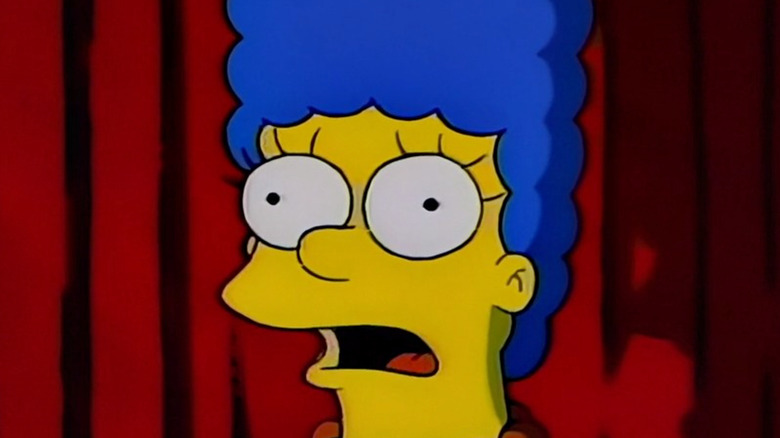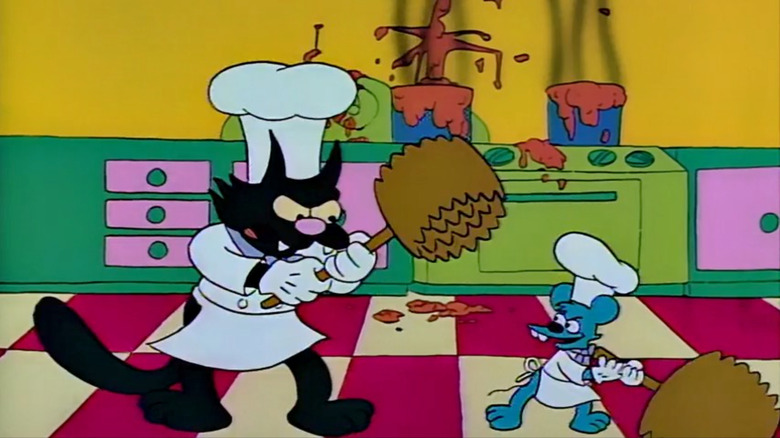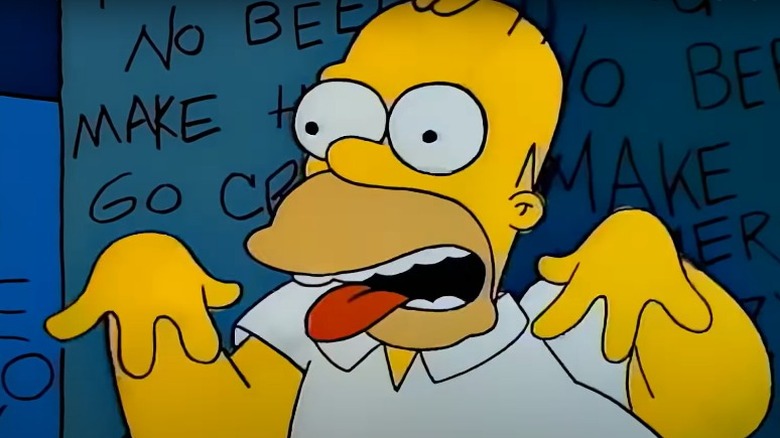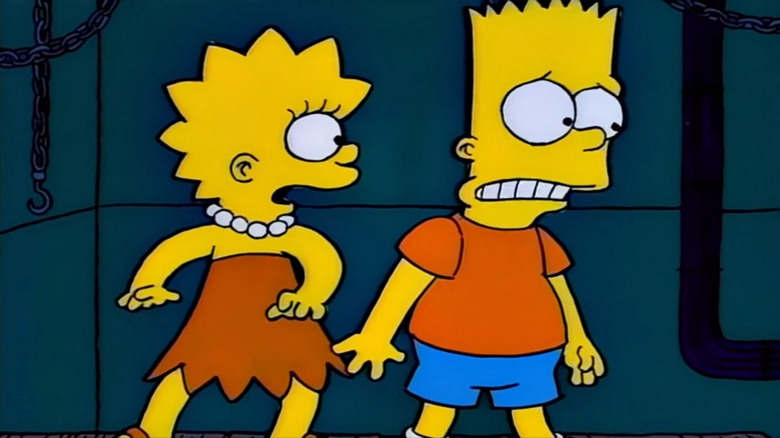The Story Behind Marge's Warning Before The Simpsons' Treehouse Of Horror V
Every fall, the long-running animated series "The Simpsons" releases their annual "Treehouse of Horror" episode, featuring three vignettes that take the show's characters out of series continuity and place them into stand-alone mini-episodes that are as hilarious as they are horrifically violent. The annual episode has parodied classic TV episodes of "The Twilight Zone," and it gave homage to "The Outer Limits" in its opening credits for "Treehouse of Horror V" in 1994. It's also placed the characters in satirical adaptions of countless horror and science fiction films, ranging from "A Nightmare on Elm Street" and "I Know What You Did Last Summer," to "The Omega Man" and "Attack of the 50 Foot Woman." Even literature isn't safe from the show writers, as works from Edgar Allan Poe and M.R. James have also been subjects of violent parody.
Fans that rewatch earlier "Treehouse of Horror" episodes will recall some of Marge's introductions, where she gives a warning of the violence and scary situations to come. In "Treehouse of Horror V," Marge emerges on an animated stage from between curtains and announces that she is there to "Warn you all that this year's Halloween episode is very, very scary and that those of you with young children may want to send them off to bed." She is then interrupted by someone offstage handing her a document. This prompts Marge to exclaim, "Oh, my. It seems the show is so scary that Congress won't let us show it!" Believe it or not, this dig at Congress was a very real (and hilarious) reaction of the show's writers to comments made by everyone's favorite branch of government.
The Simpsons was heavily criticized from the beginning
"The Simpsons" was subjected to a good amount of criticism from parent and religious groups immediately after it debuted on the fledgling Fox network with their holiday special in December 1989. Public schools across the United States were quick to ban students from wearing fan t-shirts, and even then-President George H.W. Bush threw some shade during a speech in which he said that America needed families "more like 'The Waltons' and less like 'The Simpsons'" (per Vanity Fair).
One recurring segment within the popular series is "The Itchy and Scratchy Show," a mega-violent cartoon favorite of Bart and Lisa Simpson. These short cartoon clips show an animated cat and mouse at odds with each other, with the mouse brutally torturing and killing the cat in ways that would make slasher movie directors blush. Whether Scratchy the cat is eaten alive by piranhas or filled with honey and torn apart by a bear, you can be sure that it is met with uproarious laughter from the Simpson children.
The gratuitous violence from the cartoon within the cartoon was met by its critics. CBR reports that several members of the United States Congress weren't amused by the antics of the cartoon cat and mouse, perhaps overlooking the satirical value the show's writers were looking to push. Enter show writer and producer David Merkin. Not one to be the subject of authoritarian criticism, he pulled out all the stops the next season and dedicated an entire episode to Itchy and Scratchy. But he wasn't done there.
David Merkin wasn't one to be beholden to critics
In the annual "Treehouse of Horror" episode in 1994, we have Marge announcing to the audience that Congress won't allow the network to show the special. The legislative body, Marge reads, suggests instead that the 1947 Glenn Ford film "200 Miles to Oregon" is played, prompting a black and white clip from the supposed film. After several seconds, the film cuts away, and "Treehouse of Horror V" really begins.
David Merkin did his best to make that year's installment the bloodiest ever. It opens with a parody of the Stanley Kubrick film "The Shining," renamed "The Shinning" (so as not to get sued, according to Groundskeeper Willie). Homer, a la Jack Torrence, goes berserk and tries to kill his family with an axe. After murdering Groundskeeper Willie, Homer chases the rest of the Simpson clan from the hotel and into the snow. The family is saved from the blade of the axe when the portable TV left behind by Willie is discovered, sucking Homer and his brood into watching the screen until they are all frozen solid.
From there, the show goes into its second segment, following Homer's exploits as he creates a time machine from a toaster. Every time he goes back in time, the slightest move on his part drastically alters the present. At one point in the vignette, Homer loses it and kills everything he sees.
The show's ending is a grotesque tribute to a famous musical
The third installment, "Nightmare Cafeteria," revolves around the budget of Springfield Elementary being slashed, resulting in subpar, barely-edible food being served in the cafeteria. Principal Skinner also has a problem, as the detention room of the school is becoming overcrowded. In a solution that will solve both problems, Skinner and the teachers begin eating the detention students. Becoming obsessed with their new cuisine, the faculty begins to give detention for the slightest infraction, leading to nearly every student in Springfield Elementary being on the menu. When there are just a handful of students left, a brutal ending is on the horizon as they are all herded on a catwalk that ends over the top of a giant juicer.
The annual special concludes with the Simpson family in Bart's bedroom as he awakens from a nightmare. They are horrified to see that "the fog that turns people inside out" wafts in through Bart's window, doing just that to the family. Inside out with their guts showing, the family concludes the show by singing the hit song "One" from the musical "A Chorus Line" (via AV Club). Looking at the show through the lens of time, these early seasons might pale in comparison to the excessive violence seen on primetime TV today. But David Merkin set a standard with "Treehouse of Horror" V and other episodes of this hit series, lampooning the critics with a perfect combination of absurd gore and hilarious writing.



